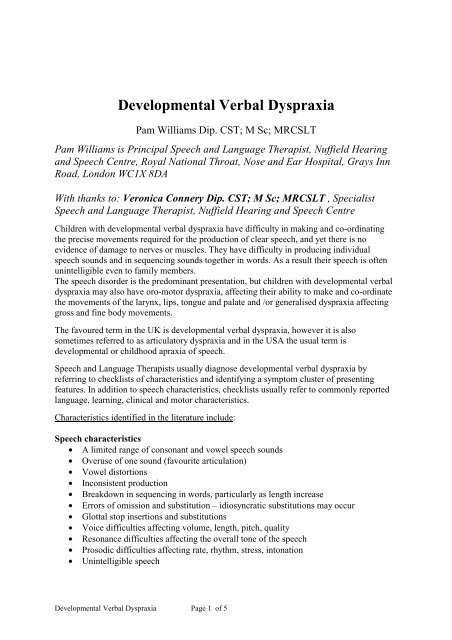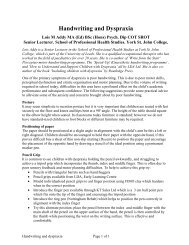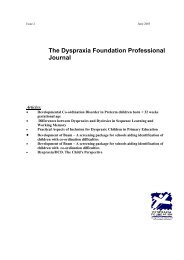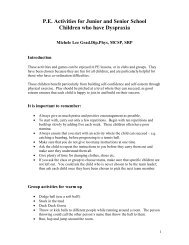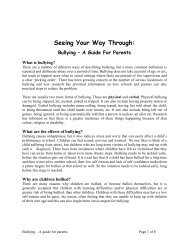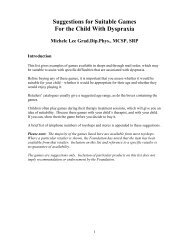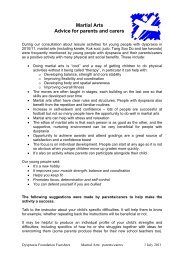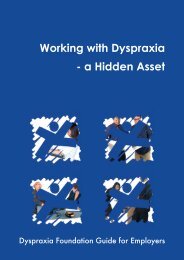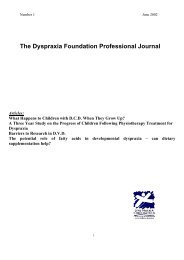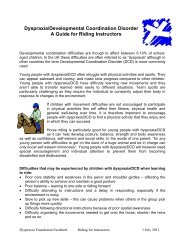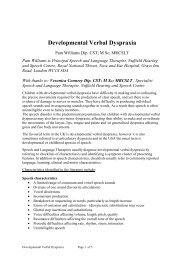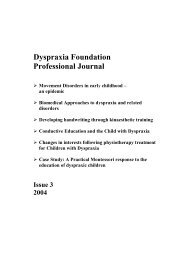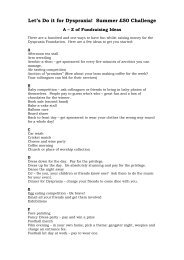Developmental Verbal Dyspraxia - Dyspraxia Foundation
Developmental Verbal Dyspraxia - Dyspraxia Foundation
Developmental Verbal Dyspraxia - Dyspraxia Foundation
You also want an ePaper? Increase the reach of your titles
YUMPU automatically turns print PDFs into web optimized ePapers that Google loves.
Co-occurring characteristics• Family history of speech, language or literacy difficulties• Delayed language development – expressive usually more affected than receptive• Delayed development of early speech skills e.g. babbling• Feeding difficulties• Oral dyspraxia affecting movements of the larynx, lips, tongue or palate• Generalised developmental dyspraxia affecting fine and /or gross motor co-ordinationLiteracy difficulties affecting reading, spelling and writing• Slow progress in therapy• Literacy difficulties under co-occurring characteristics<strong>Developmental</strong> verbal dyspraxia has been described as an unfolding and changing condition.The range of problems experienced "unfold" as the child progresses and more demands areplaced on him. As a result, the presentation of a child with developmental verbal dyspraxia isdifferent according to age and stage of development. Unfortunately, this complicatesdiagnosis.Help for children with developmental verbal dyspraxiaChildren with speech difficulties should be referred to a Speech and Language Therapist asearly as possible. This can be arranged through a GP or Health Visitor or directly bycontacting your local clinic or health centre.The Speech and Language Therapist will be able to assess your child, identify the presentingdifficulties and advise on management.Your Speech and Language Therapist will be able to advise whether a label of developmentalverbal dyspraxia is appropriate to describe your child's speech difficulties or whether anotherdescriptor is more appropriate. Diagnosis of developmental verbal dyspraxia is complex andoften becomes clearer over time.Your therapist may also prefer to describe your child's difficulties rather than assign a labeleg "Tom has a severe speech disorder, characterised by typical dyspraxic features, rather than"Tom has developmental verbal dyspraxia". This is accepted practice within the speech andlanguage therapy profession.It is generally recognised that children with developmental verbal dyspraxia do not get betterwithout help. Usually they require regular, direct therapy delivered by a Speech andLanguage Therapist, supported by frequent practise outside the therapy sessions e.g. at homeand /or in school.Speech and Language Therapists use different therapy approaches to treat children withdevelopmental verbal dyspraxia. One popular approach is The Nuffield <strong>Dyspraxia</strong>Programme (1985; 1992; 2004). It is one of the only published therapy approachesspecifically for developmental verbal dyspraxia and is used widely by Speech and LanguageTherapists in the UK and overseas. It offers a systematic approach to the assessment andtreatment of developmental verbal dyspraxia and is particularly suitable for children aged 3-7years.In the early stages of the Nuffield <strong>Dyspraxia</strong> Programme, basic oro-motor exercises areadvised to help the child develop accurate and rapid movements of all areas of the speechapparatus in preparation for co-ordinating these movements in the production of speechsounds. If you are waiting to see a Speech and Language Therapist or want to start doingsomething helpful with your child, these oromotor exercises, written by Veronica Connery,Specialist Speech and Language Therapist provide a good starting point:<strong>Developmental</strong> <strong>Verbal</strong> <strong>Dyspraxia</strong> Page 2 of 5
1.The Lips are important for control of dribbling, swallowing and blowing as well as speechsound production. During speech, some sounds, such as ‘sh’, ‘w’ and ‘oo’ need the lips tomove forwards, other sounds such as ‘ee’ and ‘m’ need the lips spread.Aims of exercise: to improve lip shapes and movements so that speech sounds can be mademore easily.Looking in a mirrorMaking funny facesOpen and shut mouthMake a big mouth like a lionMake a little mouth like a mouse etc.These will make your child more aware of his mouth and how it moves.Blowing and sucking - through different pipes, tubes, straws etc.,Helps lips make a rounded shape. Encourage him/her to hold with their lips alone, not withhis teeth as well.2. The Tongue is important for chewing, licking, and swallowing as well as playing a majorpart in speech production. During speech the separate parts of the tongue (tip, sides, backetc.) must move forwards, backwards, up, down, side to side rapidly for different sound to beproduced.Aims of exercise: to improve tongue shape and movements so that it is well controlled andplaced accurately for speech sounds.Encourage your child to practise sticking his tongue out – this helps to develop a good tip,which is essential for speech sounds. Do this while:Looking in a mirrorLicking cooking spoonsLicking lolliesTry to encourage licking games which help lick downwards onto chin:Lick sidewaysLick upwards, especially up behind the teeth.It sometimes helps to emphasise where you want his/her tongue to go if you put his/her fingerthere and ask him to lick that.NOTE: Tongue movements can be very difficult and you may find these suggestions are notworking. If this happens, leave the exercises out and concentrate on other easier areas untilthe Speech and Language Therapist can advise you.3. The Soft Palate is difficult to see, this fleshy continuation of the hard palate (roof of themouth) performs a very important function. It is responsible for the shutting of the nasalpassages and so prevents air from the lungs passing up the nasal passages, or food comingdown the nose instead of being swallowed. The soft palate adopts this position in blowing,sucking and swallowing activities and should do so for all speech sounds except ‘m’, ‘n’ and‘ng’. If it is not working efficiently, speech will have a nasal quality.<strong>Developmental</strong> <strong>Verbal</strong> <strong>Dyspraxia</strong> Page 3 of 5
Aims of exercise: to encourage easy rapid movements of the soft palate to close off the nasalpassages when appropriate in speech.Blowing activities encourage vigorous movements of the soft palate and will help developmuscle strength. If your child finds this very difficult and air comes down his nose, you canhelp by gently placing your thumb and forefinger under his/her nostrils – this will help closeoff the air stream and give him the feeling of air coming through his mouth and is morepleasant for the child than if you pinch his/her nostrils.Blowing bubbles – a wand is difficult so use a simple blower (a variety are available in toyshops)Blow painting through straws can be fun, if messy!Blowing pipes, recorders, harmonicas, etc., is enjoyable and rewarding.Blowing games are often enjoyed and will motivate him to try again – various blowing gamescan be found in toyshops as well as blow football (you can improvise with straws and cottonwool, paper or a table tennis ball).If your child tends to bite too hard on ordinary straws or can’t close his/her lips adequatelyround a straw, try plastic tubing such as that used for wine making.4. The Larynx (voice box) is responsible for production of sound during speech. Thesound is produced by air passing through the vocal chords to produce vibration. If thesemovements are weak or poorly co-ordinated the voice may be too quiet or loud, the pitch maybe too high or low, and the voice may be husky or sound weak.Aims of exercises: to improve the strength and quality of vocal tone. When encouragingyour child to use a better voice, it is important to ensure that you do not create vocal strain –just asking him to make a louder sound may result in him shouting and becoming evenhuskier.Encourage singing – using his voice with music in any way he can. A good way to motivatehim/her is to encourage dancing, clapping to music as well as singing the tune – at first don’tworry about the words, use "lala" or "ahah" or any other sound that he can manage.Play games using different voices – a baby’s, a man’s, a little girl’s, a teddy bear’s, amouse’s, other animals etc. – this helps teach control of pitch.5. Breath Control is the basis of all speech production. Speech is produced on exhalation(breathing out) and may be adversely affected by weak shallow breathing, an inability tocontrol breathing out for long enough to produce a phrase or sentence, or poor co-ordinationof breathing and speech patterns.Aim of exercises: to encourage good easy breathing for speech.a) Encourage your child to make a sound (e.g. “ah” or “ee” or “oo”), first of all for a shorttime and then gradually increasing the length of the breath and sound. Some visual cue willhelp him – run a toy car, or an animal or your finger along a line, or through amaze etc.b) Using a blowpipe and ball (available in different forms from toyshops) try to keep the ballrevolving in the air for an increasing length of time.These suggestions should give you ideas on how to help your child become aware of thestructures and movements needed for speech production and help him gain some control ofthem.<strong>Developmental</strong> <strong>Verbal</strong> <strong>Dyspraxia</strong> Page 4 of 5
SOME BASIC RULES:Make it fun - muscles will be more relaxed.Praise him for effort even when he/she doesn’t achieve the target you are aiming for.Make the activity as easy as possible for him/her (e.g. the right size straw) so he/she canachieve.Watch out for fatigue, muscles tire very quickly, so stop as soon as the child begins to fail orsays he/she doesn’t wasn’t to go on.Encourage brothers, sisters and friends to join in so that it is fun and something everyone isdoing – but watch out they are not the only one to fail the activity.Progress in control of muscles is usually very slow, so don’t be impatient, try to encouragehim to keep trying.These activities are suggested to help you until you can see a Speech and LanguageTherapist, when a programme tailored to his needs will be planned. If they are unable to doan activity do not persist – failure will only make your child more negative and make speechand language therapy even more difficult for all concerned. It is better to drop that set ofexercises and continue with one he/she can cope with until specialist advice is available.Good luck!The Nuffield Hearing and Speech Centre is a department of the Royal National Throat, Noseand Ear Hospital and a division of Royal Free Hampstead NHS Trust. It offers secondopinions to children with a variety of speech, language and hearing disorders, and isrenowned for its interest in developmental verbal dyspraxia. For further information on theclinical services of the Centre and/or referral guidelines, please contact: Pam Williams,Principal Speech and Language Therapist. Tel: 020-7915-1535 or e-mail to:pamela.williams@royalfree.nhs.ukOther useful sources of informationApraxia kids: www.apraxia-kids.orgAfasic : www.afasic.org.ukFurther information available from:<strong>Dyspraxia</strong> <strong>Foundation</strong>, 8 West Alley Hitchin Herts SG5 1EGHelpline Tel: 01462 454986Admin Tel: 01462 455016Fax: 01462 455052web: www.dyspraxiafoundation.org.uk© <strong>Dyspraxia</strong> <strong>Foundation</strong><strong>Developmental</strong> <strong>Verbal</strong> <strong>Dyspraxia</strong> Page 5 of 5


